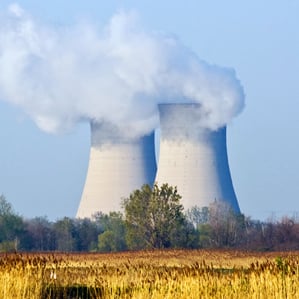Why Don’t We Have More Nuclear Power?
Nuclear reactors supply steady, low-carbon energy—a valuable commodity in a world confronting climate change. Yet nuclear power’s role has been diminishing for two decades. Bottom line: it’s just too expensive.

Concern over dependence on fossil fuels drove rapid growth in nuclear-plant construction in the 1970s and 1980s, especially after the oil crises of the 1970s. But nuclear safety became the concern after the meltdowns at Three Mile Island and Chernobyl. Meanwhile, cost overruns and delays eroded investor confidence in nuclear projects. Amid low fossil-fuel prices in the 1990s, reactor sales evaporated and the industry stagnated. The share of global power generation contributed by nuclear peaked in 1996, when it supplied 17.6 percent of the world’s electricity. Total electrical output from nuclear power peaked in 2006.
A nuclear rebound did get started a decade ago. However, the global financial crises of 2008-’09 softened energy demand, and the comeback took another blow when three reactors melted down at Tokyo Electric Power Company’s Fukushima Daiichi nuclear plant in 2011. In 2013, reactors worldwide produced 2,364 terawatt-hours of electricity, according to the U.S. Energy Information Administration, meeting 11 percent of global power demand—the share nuclear held in 1983. And last year just three new reactors started up, down from a peak of 16 in 2010 at the height of the short-lived renaissance.
Fukushima Daiichi hit the industry in myriad ways. Rising public concerns over safety shifted energy policy in some key countries. Japan scrapped plans for 14 new reactors, and all of its 48 operable reactors remain closed for safety reviews and upgrades (see “Can Japan Recapture Its Solar Power?”). Germany decided to shutter its 17 reactors, which had supplied a quarter of its power, by 2022. France, which still gets a higher percentage of its power from nuclear than any other country, elected a president promising to slash nuclear’s contribution from three-quarters of the supply to one-half by 2025.
The economics of the nuclear industry also worsened after Fukushima, according to a January report by the International Energy Agency and the OECD’s Nuclear Energy Agency. The report estimates that equipment costs have risen 20 percent since 2010, in part because of heightened safety requirements—even as low-carbon wind and solar power got cheaper.
A 2014 analysis by the financial advisory firm Lazard captures the economics holding back nuclear expansion. Lazard pegs the cost of building nuclear capacity in the United States at $5.4 million to $8.4 million per megawatt. Adding operating, maintenance, and fuel costs yields an average lifetime cost of $92 to $132 for every megawatt-hour generated. That is far above the unsubsidized costs of utility-scale solar power ($72 to $86 per megawatt-hour) and onshore wind ($37 to $81 per megawatt-hour).
Power from new natural-gas-fired plants is also far cheaper than nuclear at $61 to $87 per megawatt-hour, according to Lazard, thanks largely to gas derived from fracking in U.S. deposits. This makes natural-gas plants, rather than nuclear plants, the leading option for utilities that want to replace coal-fired power plants as a source of constant “base load” power.
In the United States, four new reactors are under construction (in Georgia and South Carolina) thanks to loan guarantees from the federal government and additional financing support from state regulators. However, five U.S. reactors have shut down in just the past two years.
The U.S. Department of Energy sees small modular reactors as a potential solution to the economic challenges facing nuclear power, but the most mature designs have yet to attract buyers. Several leading developers, including Babcock & Wilcox and Westinghouse, have recently scaled back their programs. As the IEA-NEA’s nuclear road map observes: “It seems that customers in the United States are not yet ready for [the] technology.”
Nuclear is growing in a handful of markets where it enjoys strong government backing. China’s plans, trimmed after Fukushima, still call for 88 gigawatts of nuclear capacity to be running or in construction by 2020—more than five times the output from China’s 20 operational reactors. Russia is building 10 reactors.
The takeaway:
The IEA-NEA road map makes a case for nuclear capacity to more than double, to 930 gigawatts, by 2050—which would restore nuclear to its historic high of 17 percent of the global electricity supply and displace enough coal power to cut worldwide carbon dioxide emissions by 2.5 gigatons. That represents about one-seventh of the power-sector cleanup needed to limit this century’s global temperature increase to 2 °C.
The IEA-NEA authors stress, however, that their nuclear vision is not a prediction. It is a plausible scenario only if governments, reactor suppliers, and plant operators deliver on a long list of proposed policy changes and performance improvements. For example, the document calls for the nuclear industry to demonstrate that it can build the enhanced-safety reactors that regulators are mandating, on time and on budget. Construction of such reactors, however, is now years late and billions of dollars over budget.
Rather than producing electricity too cheap to meter, nuclear power is still too expensive to build.
Do you have a big question? Send suggestions to questionoftheweek@technologyreview.com
Deep Dive
Climate change and energy
The problem with plug-in hybrids? Their drivers.
Plug-in hybrids are often sold as a transition to EVs, but new data from Europe shows we’re still underestimating the emissions they produce.
Harvard has halted its long-planned atmospheric geoengineering experiment
The decision follows years of controversy and the departure of one of the program’s key researchers.
Why hydrogen is losing the race to power cleaner cars
Batteries are dominating zero-emissions vehicles, and the fuel has better uses elsewhere.
Decarbonizing production of energy is a quick win
Clean technologies, including carbon management platforms, enable the global energy industry to play a crucial role in the transition to net zero.
Stay connected
Get the latest updates from
MIT Technology Review
Discover special offers, top stories, upcoming events, and more.